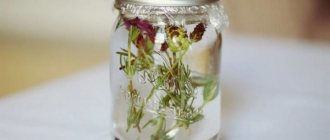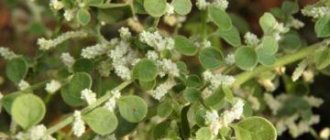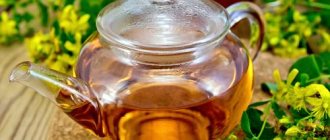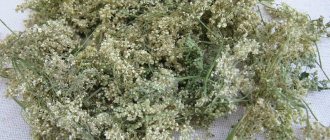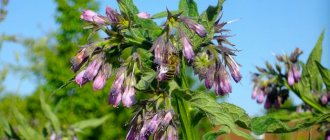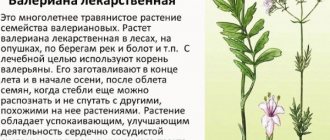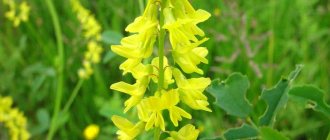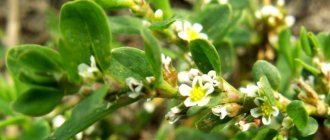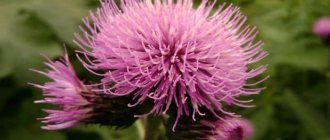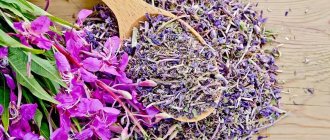Many of us know this plant as the “noxious weed,” dog nettle. And herbalists and therapists call it motherwort and consider it the best medicinal plant for women's health, cardiac and nervous systems. By the way, the ancient Greeks knew about the healing properties of dog nettle, they respected this plant in Rus', and Tibetan monks used it for treatment two thousand years ago.
Morphological description
Reaches a height of up to 2 m (usually 50-150 cm), has a straight tetrahedral stem, branching in the upper part. Beyond the inflorescences, the stem is bare or pubescent at the corners with appressed hairs. One plant has several stems.
The leaves have petioles and are dark green in color. The leaves above and below the shoot are not the same: the upper ones are oblong-rhombic in shape, whole, and the lower ones are five- or three-parted, cut to half, have wide wedge-shaped lobes with coarse-toothed edges of different sizes.
The flowers are zygomorphic and collected in false multi-flowered whorls in the axils of the upper leaves. The whorls form a discontinuous long apical inflorescence in the form of a spikelet. The calyx is bare, about 8 mm long, has a pronounced tube and consists of 5 teeth that end in a spiny point. The two lower teeth are larger and bent downwards. The corolla is five-membered, lilac-pink or pink in color, and larger than the calyx. Petals are soldered.
Inside the corolla tube is a hairy oblique ring. The upper lip has a solid edge, is elliptical in shape, densely hairy and slightly concave. The lower lip has well-developed lateral lobes. There are 4 fertile stamens collected under the upper lip - the upper ones are shorter than the lower ones. Anthers introsular. There is 1 pistil, with a superior ovary, represented by two carpels, in which false septa are formed as they mature, and the geneceum becomes four-membered. The stigma with two equal lobes is located on top of the style. Blooms all summer.
The fractional fruit consists of 4 nut-like parts, which after ripening have an olive-green color and a triangular pyramid-shaped shape, with hairs at the top. Ripens unevenly, from July to August. The seeds are characterized by high viability: germination remains up to 9 years.
What does he look like externally?
Can be quite high. And even very tall. From unsightly thirty centimeters to an impressive two meters! The root of motherwort is taproot. The stem is straight, tetrahedral, and may have branches. The leaves are petiolate. The largest ones are located at the bottom of the stem, and “on the way” to the top they gradually become smaller.
Motherwort flowers are very small, collected in inflorescences like spikelets. They are located at the ends of the stem, as well as in the leaf axils. The flower calyxes are divided into several teeth. Each flower has several stamens. The flowering period extends from June to September. Flowers grow from the upper leaf axils.
The motherwort fruit consists of several uniform single-seeded lobes resembling nuts. One such lobe is no more than three centimeters, enclosed in its own cup. Motherwort fruits cling to animal fur and thus spread throughout the area.
Chemical composition
The plant is rich in pharmacologically active substances, including:
- alkaloids (leonurine, stachydrine, leonurinine);
- iridoids (8-acetylharpagide, galiridoside, ayugol, ayugoside, harpagide);
- flavonoids (rutin, cosmosin, quinqueloside, quercetin, hyperoside);
- traces of essential oil (contains limonene, caryophyllene, linalool, α-humulene, α- and β-pinene);
- Sahara;
- tannins;
- saponins;
- bitterness;
- carotene;
- amine stachydrine;
- organic acids (tartaric, P-coumaric, malic, vanillic, ursolic, citric);
- vitamins E, C and A;
- micro- and macroelements.
Literature
| Wikisource has texts on the topic: " Leonurus Cardiaca " |
- Vermeulen N.
Motherwort // Useful herbs. Illustrated Encyclopedia / Transl. from English B. N. Golovkina. - M.: Labyrinth Press, 2002. - P. 168. - 320 p. — ISBN 5-9287-0244-2. - Gladkova V.N., Menitsky Yu.L.
Motherwort - Leonurus L. // Flora of the European part of the USSR / Responsible. ed. An. A. Fedorov. - L.: Science, 1978. - T. III. The editor of the volume is Yu. L. Menitsky. - pp. 124-125, 129, 164-166. — 259 p. — 4350 copies. - Gubanov I.A.
Motherwort // Cultivated plants of the USSR / Responsible. ed. T. A. Rabotnov. - M.: Mysl, 1978. - P. 265-266. — 336 p. — (Reference books for geographers and travelers). — 100,000 copies. - Tsvelev N.N.
Family Lamiaceae, or Labiatae // Plant life. In 6 volumes / ed. A. L. Takhtadzhyan. - M.: Education, 1981. - T. 5. Part 2. Flowering plants. — P. 404—412. — 512 s. — 300,000 copies.
- Mścisz A., Gorecki P.
Leonurus cardiaca L.: medicinal plant with sedative and cardiac activity: [English] // Herba Polonica: journal. - 1997. - Vol. 43, no. 2. - P. 172-178. — ISSN 0018-0599.
Collection and preparation
For subsequent harvesting, the entire apical part is collected along with the flowers. The optimal period is when the plant is in full bloom, when the petals are open, most often in July. For collection choose dry and sunny weather. The side shoots with the stem are cut with scissors - the workpiece should be about 40 cm long and no thicker than 5 mm.
The raw materials are laid out in a thin layer on clean paper and dried in natural conditions (in attics, verandas). During drying, the raw materials must be turned over. The finished raw material breaks with a characteristic crunch. Store in linen bags in a dry place for 3 years.
Some healers also recommend harvesting motherwort root, which is dug up at the end of the growing season, in the fall, washed and dried in dryers.
Where does it grow
The plant is found in the European part, Central Asia, Siberia, and the Urals. Prefers nitrogenous and clay-sandy soils. The name “motherwort” is associated with its favorite place of growth - wastelands; it also lives on slopes, cliffs, along roads, in gardens and vegetable gardens.
Motherwort medicinal properties
History and application in different countries
Herbs have been used in Tibetan medicine for about 2 thousand years. In the countries of modern Europe, wild nettle has been used among the population since the 10th century. In medieval medical treatises, cordial herb was used for “heartbeats and “heaviness in the stomach”, and was also used for lung diseases and as a sedative. The plant was mentioned in official European herbal books as early as the 15th century, gaining general recognition in the 19th century.
In folk medicine of Rus', the first written mentions of the pharmaceutical effects of motherwort date back to 1485. Since 1930, motherwort has become the main competitor to valerian in the treatment of heart disease, and also began to be used as a sedative.
- Bulgarians use the plant to relieve convulsions in the treatment of neuroses, as well as a diuretic and anti-tuberculosis agent.
- In the Czech Republic and Romania, the plant is used to treat tachycardia and heart pain, epilepsy and Graves' disease.
- In Ukraine, the plant is used to treat rheumatism, fear, menstrual irregularities, bronchial asthma, and eliminate cardiac and pulmonary edema.
- In England, a tincture of the plant is traditionally prescribed to people with weakness of the heart muscle and diseases of a neurological nature, especially those suffering from hysteria.
- Almost every resident of the United States has a tincture of motherwort in their medicine cabinet, which is used as a cardiac and sedative.
In Russia and Belarus, cardiac drugs are mainly used as cardiotonic and sedatives. Clinical studies have revealed positive dynamics in patients with hypertension, cardiosclerosis, angina pectoris, cardioneurosis, and myocarditis during a course of treatment. However, the greatest effectiveness can be achieved in the treatment of pathologies in the early stages of development and with long-term use of motherwort (with interruptions). Herbal medicine is not able to 100% replace chemical pharmaceuticals, but it can reduce the dosage of the latter and, accordingly, reduce the drug burden on patients.
Is it possible for children
Motherwort is not recommended for use before the age of 12. The precaution is due to the fact that detailed clinical studies of the effect of the herb on the children's body have not been conducted. Under the supervision of a doctor, a child at an early age is allowed to give motherwort only in the following cases:
- severe stress;
- hyperactivity;
- persistent sleep disturbance;
- tendency to hysteria;
- hypertension caused by diabetes.
External use of herbal remedies is allowed from birth. Babies sleep better at night if they are bathed in a bath with motherwort infusion. The herb is useful for the appearance of miliaria, eliminates inflammation, and prevents the growth of bacteria.
Motherwort is prescribed to adolescents during the period of hormonal changes in the body. For girls, herbal infusions help in establishing the menstrual cycle. A single dose depends on age. When taking, the number of drops should be equal to the number of years of the child.
Useful properties of the core
The medicinal properties of motherwort herb are varied. Among the most significant effects on the body are:
- Hypotensive effect: the core is an excellent herbal medicine for normalizing blood pressure and allows you to reduce the doses of chemically synthesized antihypertensive drugs;
- Cardiotonic, with normalization of heart rhythm: mild stimulation of the heart muscle with an increase in the amplitude of heart contractions and a decrease in their frequency;
- Antispasmodic and vasodilating effects. Leads to the expansion of coronary vessels and increased access of oxygen to the organ.
- Pronounced sedative effect: eliminates nervous excitability, improves overall well-being and normalizes sleep.
- Hormone regulating. Normalizes the menstrual cycle, relieves symptoms characteristic of menopause.
- Anticonvulsant.
- Decongestant and diuretic.
- Antioxidant.
- Hemostatic.
In addition, plant preparations improve metabolism: normalize carbohydrate, protein and fat metabolism, normalize the level of glucose, total fats, cholesterol, pyruvic and lactic acids in the blood.
According to a number of indicators, a tincture based on the plant is more effective than tinctures of valerian and hawthorn, traditionally used to treat the heart, and has fewer side effects. But the therapeutic effect of motherwort treatment comes slowly, and most people prefer stronger drugs, but fast-acting ones, which is not always justified.
Among the indications for treatment with plant preparations:
- cardiovascular neuroses, neurasthenia, psychasthenia;
- overexcitation of the central nervous system, fear;
- headache associated with nervous overload;
- VSD;
- multiple sclerosis;
- vascular and heart diseases: angina pectoris, myocarditis, cardiosclerosis, arrhythmia;
- hypertension in the early stages;
- nicotine poisoning with the development of myocardiopathy;
- gastrointestinal spasms;
- inflammatory bowel diseases;
- edema of various origins;
- bronchial asthma;
- colds;
- rheumatism;
- Graves' disease;
- uterine bleeding;
- menopausal syndrome;
- seizures (as drugs to enhance the effect of anticonvulsants).
Interesting Facts
- The seven-year-old Chinese Emperor was greatly alarmed by the prediction that he would not live to double his age. Having lost peace, the boy ordered to find a remedy that would help not only overcome the age of fourteen, but also generally live as long as possible. Healers went to all corners of the world when one wise old man came to the court and brought a stem of motherwort. “My lord,” he said, “your longevity grows in your garden.” The young ruler of the Celestial Empire listened to the sage and began to take motherwort infusion every day, full of hope that he still had a lot of time for accomplishments. And so it turned out: the ruler lived for more than 70 years
- Despite the fact that the medicinal properties of motherwort have been known for almost 2000 years, and were used by healers in different countries to treat a wide range of diseases, it was only at the end of the 19th century that it began to be used as a remedy for heart disease. In the 30s In the 20th century, thanks to the scientific research of Professor N.V. Vershinin, motherwort began to replace valerian. It was found that motherwort is 1.5 times more effective in its sedative effect than valerian officinalis.
- In magic, motherwort is assigned the following abilities: purification, protection, harmony, tranquility, longevity, healing and spirituality. The core is associated with wisdom, maternal love, and health. It is used to make amulets to protect unborn children and amulets for pregnant women.
Gallery of drawings
Pharmaceutical preparations of motherwort
Plant-based drugs are inexpensive yet effective medicines; when used correctly, they are well tolerated by patients and are not addictive.
- Motherwort extract is liquid (prepared in pharmacies) and in tablet form . Reduces general overexcitation, stabilizes heart rate, normalizes blood pressure and reduces shortness of breath in patients with essential hypertension. Effective in the treatment of myocardiopathy, which developed against the background of nicotineism, VSD.
- Motherwort tincture . The properties of the drug make it possible to prescribe it to patients with neurotic and asthenoneurotic dysfunctions with sleep disorders, neuroses accompanying the premenopausal period, and in the initial stage of arterial hypertension.
- Motherwort grass . Dry raw materials with indications similar to tincture.
It is also part of complex herbal medicines that are used for pathologies of the heart and nervous system: valemidin, tricardin, heart drops, evening, sedaphyton, etc.
Reviews of the folk remedy
- I take motherwort for VSD, it also helps with insomnia, calms and relieves tension. Can be drunk as tea. I was very pleased with this treatment.
- I make motherwort tea at night, which helps me relax after a working day. I sleep very well and don't wake up during the night. I get up in the morning by the alarm clock, completely sleepy and satisfied. Thanks motherwort.
- I was prescribed motherwort herb for VSD, as well as for the treatment of nervous excitability, since I was often nervous at work. After the first use of the infusion, I felt an improvement and became much calmer.
Motherwort has a good healing effect for many diseases. But this herb also has contraindications, so you should consult a doctor before using it.
We also invite you to watch a video on the topic of the article:
Recipes with motherwort
Various dosage forms are prepared from fresh and dry raw materials, which are recommended for certain diseases.
Motherwort tincture
The most common dosage form, which has a wide range of indications and can be used for all of the listed pathologies. You can buy it at the pharmacy, or you can prepare it yourself: take 1 part of dry raw materials and add 5 parts of 76% alcohol to it. Leave in a dark place for 21 days.
Take 30-40 drops up to 4 times a day (depending on the severity of the disease).
Aqueous infusion of herbs
Indicated for cardiac neuroses, sleep disorders, increased nervous excitability. Helps increase diuresis, promotes the removal of sputum. Take 2 tbsp. dry raw materials, pour 500 ml of boiling water and steam for 2 hours.
Take half a glass 3-4 times a day.
Tea
Recommended for long-term, course treatment up to 4 weeks. Indicated for conditions similar to infusion. For a volume of 250 ml of boiling water, take 2 tbsp. dry crushed raw materials. Leave for 10 - 15 minutes.
Take without sweeteners, drink in small sips, in 3-4 doses during the day.
Juice
One of the most effective dosage forms with the highest concentration of beneficial substances. Prescribed for hypertension, neuroses, headaches, insomnia, cardiovascular diseases, vegetative-vascular dystonia and menopausal syndrome. It is prepared from fresh leaves and stored in the refrigerator for no more than 2 days: pass the leaves through a meat grinder, squeeze the pulp through cheesecloth.
Take 1 tsp. 1.5 hours before meals, 3 times a day. within 3 weeks. As an external preparation it is indicated for the treatment of ulcers, long-term non-healing wounds, burns at the regeneration stage.
Baths
Such pleasant procedures are especially recommended for patients with VSD; they help eliminate panic attacks, improve sleep, get rid of anxiety and unmotivated fear. They are also recommended for restoring the overall strength of the body, increasing immunity, restoring heart rhythm, eliminating headaches and tachycardia. To prepare baths, you can use an aqueous infusion of the plant (1 liter per bath) or a ready-made extract in a volume of 10 ml. The bath can be taken for 15 minutes, preferably before bedtime.
Cultivation
Motherwort has been grown as a medicinal plant since ancient times, but it began to be cultivated on an industrial scale only in the middle of the 20th century[5].
| Young seedlings of motherwort (variety “Samarsky”). Smooth embryonic leaves (cotyledons) and pubescent true leaves are visible |
| Young plants of motherwort (variety “Samarsky”) |
In the USSR (according to data for the 1970s), the plant was grown in specialized state farms on the territory of the RSFSR (in Siberia), in Belarus and Ukraine; the yield was 5-6 c/ha of dry raw materials in the first year of operation of the plantation, 10-15 c/ha in the second to fourth year (sometimes up to 30 c/ha); The lifespan of the plantation was 3 or 4 years, after which it was thinned out and plowed under[5]. In Russia, motherwort is cultivated in many farms engaged in the cultivation of medicinal plants. The selection of the plant was carried out by the Middle Volga Zonal Experimental Station of the All-Russian Research Institute of Medicinal and Aromatic Plants (VILAR), where the Samarsky variety was bred and zoned[11].
Agricultural technology
The plant is unpretentious in cultivation, grows well in various climatic conditions and on various soils, including infertile ones and poorly supplied with moisture. It is recommended to grow the plant in one place for no more than 3-4 years. Seeds are sown in autumn or spring. Autumn sowing is carried out a week and a half before the onset of permanent frosts; the seeds are planted dry to a depth of 1 to 1.5 cm with a seeding rate of 1 g/m². Spring sowing is carried out after a month's stratification at a temperature of 0 to 4 °C, the seeds are planted to a depth of 2 to 3 cm with a seeding rate of 0.8 g/m²[11]. Due to the fact that the seeds are very small, if planted too deep they may be blown away by the wind, but if planted too deep, they may not sprout. In this regard, when planting this crop, you can use the following agricultural technology: in the spring, a so-called “cover crop” (for example, oats) is planted, and after it sprouts, motherwort is planted across the crops, while the cover crop not only holds the seeds , but also inhibits the growth of weeds. After the motherwort seeds sprout, the oats are mowed, and the young shoots of the motherwort overwinter under the snow[9].
Mature parts (erema) of the fractional fruit of motherwort
Plants bloom the next year after planting. In the first year of flowering, raw materials are collected once, in subsequent years - twice: at the beginning of flowering and after 1.5-2 months, when secondary shoots begin to bloom. Plants are mowed either with specialized headers (adjusted so that the mowed shoot tips are no longer than 40 cm) or manually. Drying of beveled raw materials occurs either under canopies or in special dryers that provide a temperature of 50 to 60 °C[5].
Seeds are harvested manually in the phase of their full ripening, while seed plots are not used for collecting raw materials. Freshly harvested seeds have a relatively low germination rate (about 30%), but after a few months their germination rate increases to 80-85%[11].
Herbal mixtures with motherwort
It has been proven that mixtures of plants have a more effective effect than monopreparations of motherwort.
Tea that normalizes metabolic processes in the central nervous system
Take 5 parts of valerian rhizomes, 10 parts each of lemon balm leaves, St. John's wort and hawthorn flowers, add 20 parts of motherwort to the mixture. To prepare tea, take 2 tsp. herbal mixture and pour 250 ml of boiling water. Leave for 5 minutes.
Take in small portions throughout the day.
Calming collection
Helps with VSD, anxiety, sleep disturbances, and rapid heartbeat. Take 2 parts of motherwort and 1 part each of lemon balm leaves, St. John's wort and valerian root, mix. 1 tsp pour 250 ml of boiling water over the mixture and leave for 10 minutes.
Take the resulting volume throughout the day and especially before bed.
Collection for early stages of hypertension
Take 30 grams. mistletoe, hawthorn flowers, heartsucker and marshweed. Pour this mixture with 1 liter of boiling water and leave for 2 hours in a thermos, strain and place in the refrigerator.
Take 1/3 cup 3 times a day. within 1-2 weeks. After a break of 7 days, you can repeat the course.
A collection that helps quickly reduce high blood pressure
Mix knotweed, bearberry, calamus root and motherwort in equal proportions. Take 1 tbsp. mixture and pour 1 liter of boiling water, leave in a thermos for 12 hours. Take 500 ml of vodka and dissolve 500 ml of honey in it, mix all this with herbal infusion and leave for another 9 days.
Take twice a day, morning and evening, starting with 1 tsp. and gradually increasing the dose to 1 glass per dose (increase the dose over 7 days).
Collection for dysmenorrhea and menopause (to eliminate unpleasant symptoms)
Take 25 gr. blackberry leaf, 20 gr. motherwort and fragrant woodruff, 15 gr. dried berries, 10 gr. hawthorn flowers. For 250 ml of boiling water, take 2 tsp. mixture and brew as tea, let steep for 10 minutes.
Take 1 glass throughout the day. The effect begins to appear within 7-10 days.
Collection to reduce the frequency of epileptic seizures
Take 1 tsp. heart grass, Danish astragalus, open lumbago, curly lily tubers, lemongrass berries and horsetail ephedra herb. Pour 300 ml of boiling water over the raw material and leave for 20 minutes.
Take the resulting remedy in the morning and evening, dividing the dose in half.
Collection for tremors of the hands and head (for parkinsonism, nervous system dysfunction)
Take 150 gr. hawthorn fruits, 100 gr. valerian and motherwort roots, 50 g each. hop heads, mint leaves and dill seeds, mix everything. Take 2 tbsp. mixture, pour 2 cups of boiling water, cook for 5 minutes and keep in a thermos for 2 hours.
Take 3 times a day, 50 ml. Every day you will have to prepare a new portion of the drug and take it for a month, then take a break for 10 days and take it again for 1 month.
Collection for infertility
Take equal parts of calendula flowers, motherwort, immortelle, chamomile, St. John's wort, buckthorn bark, yarrow, horsetail, bearberry and plantain. Mix everything and take 10 tsp per 500 ml of boiling water. mixture, leave for 2 hours.
Take 100 ml three times a day, 2 months before expected conception.
Notes
- For the convention of indicating the class of dicotyledons as a superior taxon for the group of plants described in this article, see the section “APG Systems” of the article “Dicotyledons”.
- ↑ 1234567891011
Gladkova, Menitsky, 1978. - ↑ 1234567
Vermeulen, 2002. - Information about the genus Leonurus
Index Nominum Genericorum
database of the International Association for Plant Taxonomy (IAPT). (Accessed May 11, 2018) - ↑ 12345678910
Gubanov, 1978. - Cheng, F., Zhou, Y., Wang, M., Guo, C., Cao, Z., Zhang, R., & Peng, C. (2020). A review of pharmacological and pharmacokinetic properties of stachydrine. Pharmacological Research 155:104755. PMID 32173585 doi:10.1016/j.phrs.2020.104755
- ↑ 1234
Hanelt, 2001. - Motherwort grass, SFRF, XIII edition, 2015.
- ↑ 12
"Evalar" - full cycle production // Fitodoctor. — 2021. — No. 1 (51) (spring-summer). — P. 22-23. - ↑ 1 2 3 Gubanov I. A. et al.
Wild useful plants of the USSR / resp. ed. T. A. Rabotnov. - M.: Mysl, 1976. - P. 283-284. — 360 s. — (Reference books for geographers and travelers). - ↑ 1 2 3 Malankina E. L..
Motherwort cordial, five-lobed and others: [arch. 01.11.2016]. - GreenInfo.Ru. — Date of access: 05/11/2018. - Leonurus cardiaca
Linnaeus: [arch. 05/02/2018]: [English] // The Linnaean Plant Name Typification Project. — London: The Natural History Museum. — Date of access: 05/02/2018. - Leonurus cardiaca
L.: [arch. 05.12.2018]: [English] // Germplasm Resources Information Network (GRIN-Taxonomy) / National Germplasm Resources Laboratory. — Beltsville, Maryland: USDA, Agricultural Research Service, National Plant Germplasm System. — Date of access: 05/12/2018. - Leonurus cardiaca
L.: [arch. 04/08/2018]: [English] // The Plant List. Version 1.1. — Royal Botanic Gardens, Kew & Missouri Botanical Garden, 2013. — Access date: 04/30/2018.
